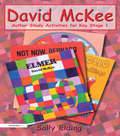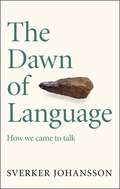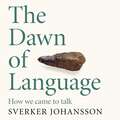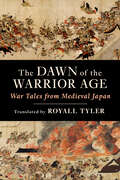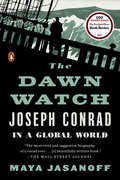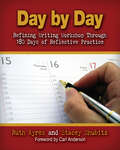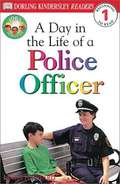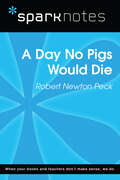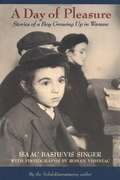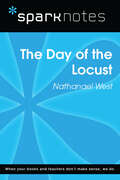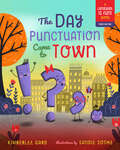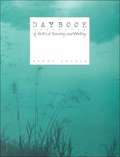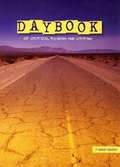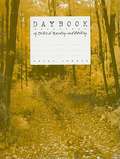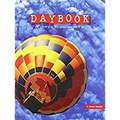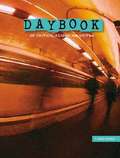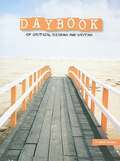- Table View
- List View
David McKee: Author Study Activities for Key Stage 1 (A Health Care for Women International Publication)
by Sally EldingThis innovative series is designed to help primary teachers plan focused sessions on the work of popular, well-loved and valued authors, both classic and contemporary. Each book contains a range of activities for use directly in the classroom, covering biographical information about the author; a review of the author's work and a summary of major themes in his/her key texts; key language features of the author; frameworks to help children analyze, evaluate and compare texts, and to develop personal opinions of authors' works; ideas for writing modeled on or developed from key texts; speaking and listening opportunities; drama and role play ideas; and references to video, CD-ROM, websites and ICT activities. Inside each book is a full-color pullout poster illustrating the work of the author, which also has a set of challenges for children on the back. David McKee is an author and illustrator, creator of Mr Benn, King Rollo, and the ever-popular patchwork elephant, Elmer. Building on children's enjoyment of the characters and their adventures, this book presents activities that focus on narrative structure, character development, settings and themes. Most importantly, the activities are designed to make learning about stories as much fun as reading them. Games and activities include: fortunately/unfortunately and chain of events - exploring cause and effect; comparing plots - using a matrix to order information; looking for clues about Elmer - building a character sketch; mapping feelings - exploring character development; time talk and Isabel's diary - understanding setting, sequence and relationships between the two; making a story map - recognizing picture and context clues; comparing the video to the written text; and text detective work using extracts.
The Dawn of Language: The story of how we came to talk
by Sverker Johansson"A model of popular-science writing" STEVEN POOLEWho was "the first speaker" and what was their first message?An erudite, tightly woven and beautifully written account of one of humanity's greatest mysteries - the origins of language.Drawing on evidence from many fields, including archaeology, anthropology, neurology and linguistics, Sverker Johansson weaves these disparate threads together to show how our human ancestors evolved into language users. The Dawn of Language provides a fascinating survey of how grammar came into being and the differences or similarities between languages spoken around the world, before exploring how language eventually emerged in the very remote human past.Our intellectual and physiological changes through the process of evolution both have a bearing on our ability to acquire language. But to what extent is the evolution of language dependent on genes, or on environment? How has language evolved further, and how is it changing now, in the process of globalisation? And which aspects of language ensure that robots are not yet intelligent enough to reconstruct how language has evolved? Johansson's far-reaching, authoritative and research-based approach to language is brought to life through dozens of astonishing examples, both human and animal, in a fascinatingly erudite and entertaining volume for anyone who has ever contemplated not just why we speak the way we do, but why we speak at all.Translated from the Swedish by Frank Perry
The Dawn of Language: The story of how we came to talk
by Sverker JohanssonAn erudite, tightly woven and beautifully written account of one of humanity's greatest mysteries - the origins of language.Who was "the first speaker" and what was their first message?Drawing on evidence from many fields, including archaeology, anthropology, neurology and linguistics, Sverker Johansson weaves these disparate threads together to show how our human ancestors evolved into language users. The Dawn of Language provides a fascinating survey of how grammar came into being and the differences or similarities between languages spoken around the world, before exploring how language eventually emerged in the very remote human past.Our intellectual and physiological changes through the process of evolution both have a bearing on our ability to acquire language. But to what extent is the evolution of language dependent on genes, or on environment? How has language evolved further, and how is it changing now, in the process of globalisation? And which aspects of language ensure that robots are not yet intelligent enough to reconstruct how language has evolved? Johansson's far-reaching, authoritative and research-based approach to language is brought to life through dozens of astonishing examples, both human and animal, in a fascinatingly erudite and entertaining volume for anyone who has ever contemplated not just why we speak the way we do, but why we speak at all.Sverker Johansson's claim to fame otherwise is to have invented the LSJBot, which has written 8% of all articles on Swedish Wikipedia. He is also a physicist, has conducted research at CERN and participated in EVOLANG, a leading international research conference on language.TRANSLATED FROM THE SWEDISH BY FRANK PERRY(P) 2021 Quercus Editions Limited
The Dawn of Language: The story of how we came to talk
by Sverker Johansson"A model of popular-science writing" STEVEN POOLEWho was "the first speaker" and what was their first message?An erudite, tightly woven and beautifully written account of one of humanity's greatest mysteries - the origins of language.Drawing on evidence from many fields, including archaeology, anthropology, neurology and linguistics, Sverker Johansson weaves these disparate threads together to show how our human ancestors evolved into language users. The Dawn of Language provides a fascinating survey of how grammar came into being and the differences or similarities between languages spoken around the world, before exploring how language eventually emerged in the very remote human past.Our intellectual and physiological changes through the process of evolution both have a bearing on our ability to acquire language. But to what extent is the evolution of language dependent on genes, or on environment? How has language evolved further, and how is it changing now, in the process of globalisation? And which aspects of language ensure that robots are not yet intelligent enough to reconstruct how language has evolved? Johansson's far-reaching, authoritative and research-based approach to language is brought to life through dozens of astonishing examples, both human and animal, in a fascinatingly erudite and entertaining volume for anyone who has ever contemplated not just why we speak the way we do, but why we speak at all.Translated from the Swedish by Frank Perry
The Dawn of the Warrior Age: War Tales from Medieval Japan
by Royall TylerThe war between the Heike and Genji clans in the twelfth and thirteenth centuries is among the most compelling and significant moments in Japan’s history, immortalized in The Tale of the Heike. Beyond the events recorded in this canonical text, the conflicts of the surrounding years are crucial to medieval Japanese culture and history. In 1156, power began to slip away from the court nobility in Kyoto. A shogunate was later founded in Kamakura, and in 1221, it won a decisive victory over the court.The three war tales translated in this book tell the story of these critical decades, vividly recording stages in the passage from rule by the imperial court in Kyoto to rule by the warrior government in Kamakura. “The Tale of the Hōgen Years” recounts a deposed emperor’s disastrous attempt to regain the throne in 1156. “The Tale of the Heiji Years” narrates a bloody clash between rival courtier factions in 1159. “An Account of the Jōkyū Years” records Kamakura’s victory over the imperial attempt to overthrow it in 1221. These works do not simply complete the story of The Tale of the Heike—they are classics of Japanese literature in their own right. Royall Tyler’s lively translation masterfully conveys the nature of medieval Japanese warfare, rendering aristocratic power politics and the brutal realities of violence with equal aplomb. The Dawn of the Warrior Age is an essential book for readers interested in premodern Japanese history and literature.
The Dawn That Never Comes: Shimazaki Toson and Japanese Nationalism (Studies of the Weatherhead East Asian Institute, Columbia University)
by Michael BourdaghsA critical rethinking of theories of national imagination, The Dawn That Never Comes offers the most detailed reading to date in English of one of modern Japan's most influential poets and novelists, Shimazaki Toson (1872–1943). It also reveals how Toson's works influenced the production of a fluid, shifting form of national imagination that has characterized twentieth-century Japan. Analyzing Toson's major works, Michael K. Bourdaghs demonstrates that the construction of national imagination requires a complex interweaving of varied—and sometimes contradictory—figures for imagining the national community. Many scholars have shown, for example, that modern hygiene has functioned in nationalist thought as a method of excluding foreign others as diseased. This study explores the multiple images of illness appearing in Toson's fiction to demonstrate that hygiene employs more than one model of pathology, and it reveals how this multiplicity functioned to produce the combinations of exclusion and assimilation required to sustain a sense of national community. Others have argued that nationalism is inherently ambivalent and self-contradictory; Bourdaghs shows more concretely both how this is so and why it is necessary and provides, in the process, a new way of thinking about national imagination. Individual chapters take up such issues as modern medicine and the discourses of national health; ideologies of the family and its representation in modern literary works; the gendering of the canon of national literature; and the multiple forms of space and time that narratives of national history require.
The Dawn That Never Comes: Shimazaki T son and Japanese Nationalism
by Michael BourdaghsA critical rethinking of theories of national imagination, The Dawn That Never Comes offers the most detailed reading to date in English of one of modern Japan's most influential poets and novelists. This book surveys the ideologies of national imagination at play in early-twentieth-century Japan, specifically in the work of Shimazaki Toson (1872-1943). Bourdaghs analyzes Toson's major works in detail, using them to demonstrate that the field of national imagination requires a complex interweaving of varied--and sometimes even contradictory--figures for imagining the national community.
The Dawn Watch: Joseph Conrad in a Global World
by Maya Jasanoff“Enlightening, compassionate, superb” —John Le CarréA visionary exploration of the life and times of Joseph Conrad, his turbulent age of globalization and our own, from one of the most exciting young historians writing todayMigration, terrorism, the tensions between global capitalism and nationalism, and a communications revolution: these forces shaped Joseph Conrad’s destiny at the dawn of the twentieth century. In this brilliant new interpretation of one of the great voices in modern literature, Maya Jasanoff reveals Conrad as a prophet of globalization. As an immigrant from Poland to England, and in travels from Malaya to Congo to the Caribbean, Conrad navigated an interconnected world, and captured it in a literary oeuvre of extraordinary depth. His life story delivers a history of globalization from the inside out, and reflects powerfully on the aspirations and challenges of the modern world. Joseph Conrad was born Józef Teodor Konrad Korzeniowski in 1857, to Polish parents in the Russian Empire. At sixteen he left the landlocked heart of Europe to become a sailor, and for the next twenty years travelled the world’s oceans before settling permanently in England as an author. He saw the surging, competitive "new imperialism" that planted a flag in almost every populated part of the globe. He got a close look, too, at the places “beyond the end of telegraph cables and mail-boat lines,” and the hypocrisy of the west’s most cherished ideals. In a compelling blend of history, biography, and travelogue, Maya Jasanoff follows Conrad’s routes and the stories of his four greatest works—The Secret Agent, Lord Jim, Heart of Darkness, and Nostromo. Genre-bending, intellectually thrilling, and deeply humane, The Dawn Watch embarks on a spell-binding expedition into the dark heart of Conrad’s world—and through it to our own.
A Day at the Beach: A Grammar Tales Book to Support Grammar and Language Development in Children (Grammar Tales)
by Jessica HabibPete, Jem and Belle are enjoying a day at the beach until the weather turns stormy. Targeting Subject-Verb-Object sentences and early adjectives, this book provides repeated examples of early developing syntax and morphology which will engage and excite the reader while building pre-literacy skills and make learning fun, as well as exposing children to multiple models of the target grammar form. Perfect for a speech and language therapy session, this book is an ideal starting point for targeting client goals and can also be enjoyed at school or home to reinforce what has been taught in the therapy session.
Day by Day: Refining Writing Workshop Through 180 Days of Reflective Practice
by Ruth Ayres Stacey ShubitzHave you ever wanted your own personal writing coach to help improve your teaching of writing? How about two personal writing coaches? In Day by Day, Stacey Shubitz and Ruth Ayres, creators of the popular blog Two Writing Teachers, guide you through the trials and tribulations of a whole year of writing workshop. ' Day by Day is organized around six fundamental components of writing workshoproutines, mini-lessons, choice, mentors, conferring, and assessment. Each component is broken down into ten-day sections. Each section includes a detailed discussion, a challenge that teachers can apply immediately,' and questions to help teachers assess the process to see what went right, what went wrong, and, most importantly, why.' Ruth and Stacey also provide daily encouragement, support, practical strategies, tips, advice, and everything you need to run an effective writing workshop that meets the needs of all the different writers in your classroom.
A Day In The Country: An Alphabet Story
by Liza AlexanderThis is a lively alphabet book featuring the Sesame Street characters. The Sesame Street gang go to the countryside. While there they entertain themselves by searching for things that start with the letters of the alphabet.
A Day in the Life of a Police Officer (Darling Kindersley Readers )
by Linda HaywardThe duties of police officers are simply explained to young readers in this book that features short sentences, simple vocabulary, word repetition, and visual clue to help readers learn new words.
The Day Lasts More than a Hundred Years
by Chingiz Aitmatov" . . . a rewarding book." —Times Literary SupplementSet in the vast windswept Central Asian steppes and the infinite reaches of galactic space, this powerful novel offers a vivid view of the culture and values of the Soviet Union's Central Asian peoples.
A Day No Pigs Would Die (SparkNotes Literature Guide Series)
by SparkNotesA Day No Pigs Would Die (SparkNotes Literature Guide) by Robert Newton Peck Making the reading experience fun! Created by Harvard students for students everywhere, SparkNotes is a new breed of study guide: smarter, better, faster.Geared to what today's students need to know, SparkNotes provides:chapter-by-chapter analysis explanations of key themes, motifs, and symbols a review quiz and essay topics Lively and accessible, these guides are perfect for late-night studying and writing papers.
A Day of Pleasure: Stories of a Boy Growing Up in Warsaw
by Isaac Bashevis SingerMr. Singer has created out of remembered fragments of his own childhood a place instantly familiar where life is not neat and orderly.<P><P> Winner of the National Book Award
The Day of the Locust (SparkNotes Literature Guide Series)
by SparkNotesThe Day of the Locust (SparkNotes Literature Guide) by Nathanael West Making the reading experience fun! Created by Harvard students for students everywhere, SparkNotes is a new breed of study guide: smarter, better, faster. Geared to what today's students need to know, SparkNotes provides chapter-by-chapter analysis; explanations of key themes, motifs, and symbols; and a review quiz and essay topics. Lively and accessible, these guides are perfect for late-night studying and writing papers.
The Day Punctuation Came to Town (Language Is Fun! Ser. #2)
by Kimberlee GardRunner-up for the Reading the West Book Awards
The Day Without Yesterday
by William RossbachBranch Nichols, adventurer, mystery writer, and eternal skeptic, must travel the globe to acquire nine parts to a pyramid, each being safeguarded by members of a 4000-year-old secret organization known as the Pyramidions. When assembled, the pyramid becomes a key. But what does is unlock, and what would it mean for mankind? He makes the journey with his lifelong friend, Roddy, and a pesky female archeology writer, Linda, while being relentlessly pursued by assassins. Questions abound: why was the pyramid of Giza built; how was it built; who was ultimately behind its construction? And what “secret” world power has the most to lose if they complete their quest? Truth—scientific, political, and historical—meets with exotic adventure as the three have their understanding of the world, and how it works, shattered and reformed with each new mind-boggling revelation. The past isn’t what it used to be.
Daybook of Critical Reading and Writing (Grade #7)
by Fran Claggett Louann Reid Ruth VinzEach level includes 80 lessons. Use them to fit your teaching schedule. Teach a lesson daily for single semester. Use within a block schedule format. Teach several times weekly for a school year.
Daybook of Critical Reading and Writing (Grade #6)
by Fran Claggett Louann Reid Ruth VinzThroughout this Daybook, you will read, respond to, and write about many different kinds of texts. You will read and write for a variety of purposes.
Daybook of Critical Reading and Writing (Grade #6)
by Great Source Education TeamThroughout this Daybook, you'll be asked to read and respond to many different kinds of literature. You'll circle, underline, and highlight. You'll make guesses, ask questions, and think about word meanings. You'll draw pictures, brainstorm, and do some writing of your own. In short, you'll look at what you read and what you write in many different ways. You'll learn to respond to literature in a whole new way by becoming an active reader.
Daybook of Critical Reading and Writing (Grade #5)
by Laura Robb Michael F. Opitz Ellin Oliver KeeneA literature and language arts book that aims at harnessing the students' critiical reading and writing skills
Daybook of Critical Reading and Writing [Grade 7]
by Fran Claggett Louann Reid Ruth VinzNIMAC-sourced textbook
Daybook of Critical Reading and Writing [Grade 8]
by Fran Claggett Louann Reid Ruth VinzNIMAC-sourced textbook
